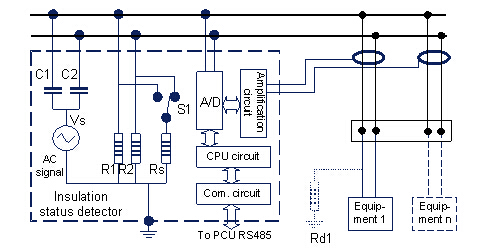DC Power
Parts of PS
index > DC Power > Parts of PS
Emerson JYM-II (JYM-IIA, JYM-I ) Insulation Status Detector
editor:admin date:2014-07-22
Operation Principle of JYM-II (JYM-IIA ,JYM-I)
The operation principle of the IMS JYM-II is shown in the following diagram.

Operation principle of IMS
The work of an IMS comprises two parts: routine monitoring and branch polling. In routine monitoring, when the system is in normal operation, the detector real-time observes the to-ground voltage of the positive and negative buses and calculates the bus insulation resistance. Upon bus insulation deterioration, it will raise alarms, turn on the fault indicator, report the fault signal to the PCU, and send low-frequency signals to the branches. If the branch has grounding resistance, the local mutual inductor will induce a current signal, which will, after amplification, enter AD sampling circuit, where the grounding impedance of the branch can be figured out. Consequently, the grounding resistance can be figured out by separating the resistive current from capacitive current.
If the branch grounding capacitance is big (more than 2uF), the measurement precision of the branch grounding resistance will be affected. JYM-II IMS uses the capacitance auto-compensation technology to solve the problem. First, it calculates the branch capacitance. Then, it triggers an internal capacitance of the same value. By making a low frequency AC signal reverse-pass the mutual inductor of the branch through a correction cable, the effect resulting from the grounding capacitance is eliminated.
Functions And Features
The IMS has the following functions and features:
1. Real-time monitoring combined with branch polling.
2. RS485 serial port communication with PCU.
3. Capable of monitoring one or two sections of independent DC buses, with no need for configuration of bus voltage levels.
4. In master & slave mode. Each slave can monitor 24 branches, and each bus section can have 16 slaves, or 32 for two bus sections, which means a polling of 768 branches can be realized. With built-in auxiliary power, the slave can be located far away from the master.
5. Automatic capacitance compensation function addressing the big branch capacitance, ensuring measurement precision of branch grounding resistance.
6. Alarm threshold configurable through the PCU, adaptive to different climates.
7. Capable of monitoring equal insulation deterioration at positive bus and negative bus.
8. Capable of self-checking, convenient for maintenance.
9. The master being capable of dry contract output for dual-section bus poor insulation alarm.
Specifications
The technical specifications of the IMS are listed in the following table.
IMS JYM-II technical parameters
|
No.
|
Item
|
Specification
|
|
|
1
|
Ambient temperature
|
-5 ~ +40°C
|
|
|
2
|
Relative humidity
|
[90%
|
|
|
3
|
Work power
|
80 ~ 320Vdc
|
|
|
4
|
Power consumption
|
<20W
|
|
|
5
|
Weight
|
Master: <4kg Slave: <1.5kg
|
|
|
6
|
Voltage measurement accuracy (0 ~ 320V)
|
1% (full measurement range)
|
|
|
7
|
Insulation resistance alarm threshold
|
0.5 ~ 50kΩ (default: 20kΩ)
|
|
|
8
|
Number of slaves
|
1 ~ 32
|
|
|
9
|
Number of detected branches
|
Max.: 768
|
|
|
10
|
System grounding resistance measurement accuracy
|
0 ~ 2kΩ: 1kΩ
2 ~ 50kΩ: 15%
|
|
|
11
|
Branch grounding resistance measurement accuracy (with the grounding capacitance of single branch smaller than 30uF)
|
Pure resistive branch
|
0 ~ 2kΩ: 1kΩ
|
|
2 ~ 25kΩ: 15%
|
|||
|
Capacitive branch
|
0 ~ 25kΩ: 2kΩ or 30%
|
||
|
12
|
Branch polling time
|
2 ~ 4s
|
|
|
13
|
Amplitude and frequency of low frequency signal
|
About 4V, 10 ± 0.1Hz
|
|
|
14
|
Communication interface
|
RS485
|
|
|
15
|
Alarm point hysteresis
|
40%
|
|